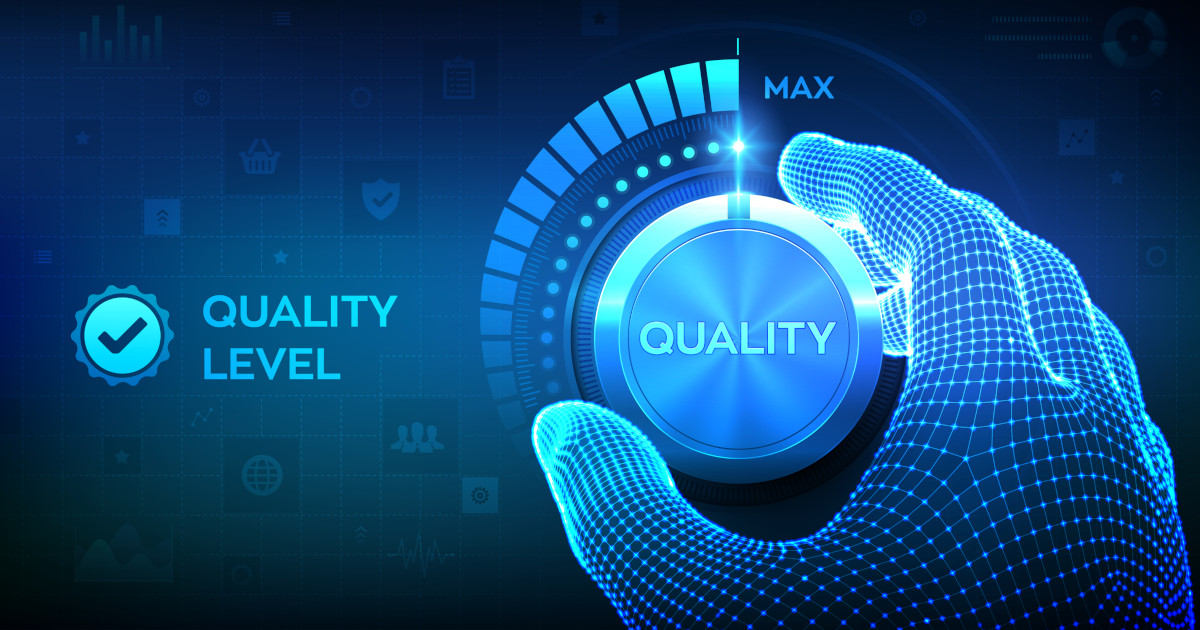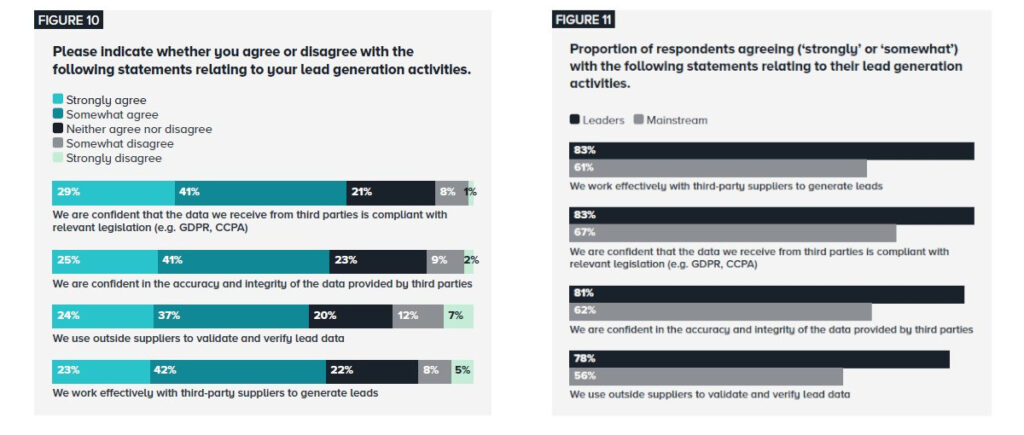B2B Lead Generation

Maximize Your B2B Demand Gen with High-Quality Data
Let’s talk about the crucial role of high-quality data in powering up your B2B demand generation efforts.
As a marketer, you know that securing high-quality sales leads is the linchpin to a thriving B2B marketing strategy.
It’s a clear challenge we all face – moving beyond just gathering leads to ensuring each one brings genuine value to the table.
Imagine this scenario: every lead you engage is a step closer to becoming a loyal customer, simply because your data told you they’re the right fit.
That’s the power of improving customer data quality in your marketing strategies.
So, why zero in on data quality? The answer is straightforward.
With precise, relevant, and actionable data, your demand gen campaigns can cut through the noise.
It turns common hurdles into stepping stones for more effective lead generation, where every piece of data adds value to your campaign’s success.
You must look beyond the numbers and focus on the quality that drives conversions and growth.
Let’s explore how strategic data quality can elevate your demand generation strategy, making every effort count towards achieving your marketing goals.
The Growing Challenge of Lead Quality in B2B Demand Generation
B2B marketers are no strangers to the constant pursuit of high-quality sales-qualified leads.
It’s a challenge that has only grown more pressing over time, as evidenced by the insightful data in our infographic.

The numbers speak volumes:
- A staggering 40% of respondents cited lead quality as one of their top three B2B demand generation challenges – a standout barrier to success.
- This issue has steadily escalated, with lead quality concerns rising from 30% in 2017 to its current peak of 40%.
While hurdles like tracking ROI and generating sufficient lead volume persist, the growing preeminence of lead quality issues cannot be ignored.
It’s a wake-up call for B2B marketers to adopt a targeted and effective demand generation strategy that prioritizes data quality.
As Nick Mamouzellos, Director of Demand Generation at LRN, aptly states in our State of B2B Lead Generation 2024 report:
“At some point, every business will have issues with the quality of leads produced. When our leads-to-meetings booked ratio dropped significantly, we knew that we had to drastically tackle this issue given our high revenue targets, and the fact that a third of that revenue would come from inbound leads. As with every difficult situation, there lies an opportunity to grow and improve.”
The opportunity is clear: by confronting lead quality head-on and leveraging high-quality data to improve your demand generation efforts, you can unlock significant growth potential for your B2B business.
Do these findings resonate with your own experiences in B2B demand generation?
How Do You Generate High-Quality B2B Sales Leads?
Generating high-quality B2B sales leads is the holy grail of demand generation.
It’s a challenge that requires a multi-faceted approach, with high-quality, validated data at its core.
Here are some key strategies to consider:
- Invest in robust data validation and verification processes to ensure the accuracy and integrity of your lead data. The infographic highlights that leaders are significantly more likely (78%) to use outside suppliers for this purpose compared to the mainstream (56%).
- Leverage intent data and behavioral signals to identify prospects who are actively researching solutions like yours. This allows you to prioritize the hottest leads and personalize your outreach.
- Implement lead scoring models that incorporate comprehensive data points – from demographics to online activity – to pinpoint the leads most likely to convert.
- Nurture leads through targeted, multi-channel campaigns that deliver value and build trust, guiding them down the sales funnel.
Most crucially, partner with the right data providers who can supply you with the high-quality fuel to power your demand generation engine.
The infographic underscores that leaders are more confident in the accuracy (81% vs. 62%) of third-party data compared to the mainstream.
The Crucial Role of Data in B2B Marketing
Accurate and comprehensive data is the foundation upon which all successful marketing strategies are built.
It’s the cornerstone of effective B2B demand generation.
Each year, more B2B businesses struggle with data quality and integration issues.
Making it harder to execute effective demand generation campaigns without embracing a comprehensive, data-driven strategy.
A data-driven demand gen strategy empowers you to:
- Identify and prioritize your most valuable prospects based on real-time insights.
- Craft compelling, personalized content that speaks directly to their pain points.
- Optimize your campaigns for maximum ROI by continuously fine-tuning based on performance data.
- Align your marketing and sales efforts through a unified, comprehensive view of the potential customer.
In essence, high-quality data allows you to cut through the noise, engage your target audience with precision, and ultimately accelerate conversions along the entire sales funnel.

What is a Data-Driven Demand Gen Strategy?
A truly data-driven demand gen strategy is one that places high-quality data at the center of every decision and action.
It’s about leveraging accurate, up-to-date insights to:
- Define your ideal customer profile and target accounts with precision
- Develop compelling content marketing campaigns that resonate with your target
- Determine the optimal channels and tactics to reach your audiences
- Continuously measure, test, and refine your approaches for maximum impact
The State of B2B Lead Generation 2024 report reveals that only 25% of businesses strongly agree they have a clear strategy for online lead generation (Figure 9), with individual campaigns fitting into an overarching framework.
An effective, data-driven demand gen strategy provides that strategic clarity and cohesion.
As Phil Guest, CEO and Founder of Revcelerate, stated: “This evolution points to a pressing need for more refined strategies and investment in advanced analytics and technologies to accurately measure ROI and efficiently scale lead gen efforts.”
With unified customer data as your North Star, you can confidently chart a course towards generating high-quality leads and accelerating revenue growth.
Best Practices for Improving B2B Customer Data Quality
While the importance of data is clear, the challenge lies in ensuring its quality and accuracy.
Here are some key steps to improve your B2B customer data:
- Implement rigorous data validation and verification processes, whether in-house or through third-party providers.
- Leverage marketing automation and CRM platforms to capture and integrate data from multiple touchpoints, creating a comprehensive customer view.
- Regularly cleanse and enrich your data by removing outdated records and appending missing information.
- Establish clear data governance policies and train your teams on best practices for data management.
Technology is a pivotal enabler, with 32% strongly agreeing their platforms allow efficient data capture (Figure 9).
The right tools can streamline data collection, validation, and integration – ensuring your decision-making is fueled by high-quality insights.
Leveraging Diverse Data Types for Comprehensive Customer Insights
To truly understand your customers and prospects, a multi-dimensional view is essential.
This means tapping into diverse data sources, including:
- Demographic data: Firmographic details, decision-maker roles, company size, industry, etc.
- Behavioral data: Website interactions, email engagement, content consumption patterns.
- Intent data: Topics being researched, solutions explored, buying signals.
- Third-party data: Enriched company and contact information from trusted providers.
Integrating these varied data points unlocks a 360-degree perspective, allowing you to map the customer journey, identify key moments of influence, and deliver contextually relevant experiences.
The report highlights a measured confidence in third-party data sources, with 25% strongly agreeing about accuracy and integrity, and 29% about legal compliance (Figure 10).
As you evaluate partners, stringent data quality standards are critical.
Navigating Third-Party Supplier Relationships for Lead Generation Success
As a B2B marketer, you understand that securing high-quality data often necessitates strategic partnerships with third-party suppliers.
The key is navigating these relationships effectively to maximize their value for your lead generation efforts.
The report reveals some compelling insights in Figures 10 & 11:
- Only 23% strongly agree they work effectively with third parties to generate leads.
- However, leaders outpace the mainstream, with 83% indicating effective third-party collaboration compared to just 61%.

Clearly, there’s an opportunity to strengthen these crucial partnerships.
Foster open communication and alignment from the outset by:
- Defining shared goals, metrics for success, and expectations clearly.
- Establishing robust processes for data sharing, validation, and compliance checks.
Leverage your partners’ expertise by:
- Seeking their guidance on emerging trends, data sources, and best practices.
- Collaborating on campaign strategies and audience targeting approaches.
Implement rigorous performance tracking by:
- Monitoring lead quality, conversion rates, and overall ROI across sources.
- Using this data to optimize your mix of partners and data investments continuously.
By cultivating true partnerships built on transparency and shared accountability, you can achieve similar gains in data quality and performance.
Conclusion
The path to demand generation success is paved with high-quality data.
As we’ve explored, confronting lead quality challenges head-on and leveraging accurate, comprehensive data is crucial for:
- Identifying and engaging your most valuable prospects
- Delivering personalized, resonant experiences across channels
- Optimizing campaign performance and maximizing ROI
- Aligning your marketing and sales efforts for a seamless customer journey
How effectively are you harnessing data to fuel your demand generation engine?
Are you partnering with the right suppliers to access the high-quality insights you need?
Have you invested in the processes, technologies, and strategies to ensure data quality and accuracy?
If the answer is no, you’re leaving significant revenue potential on the table.
But it’s never too late to course-correct.
I encourage you to explore our comprehensive “State of B2B Lead Generation 2024” report for deeper insights and actionable guidance on optimizing your data-driven demand gen strategy.
Demand Generation Success with High-Quality Data
At Demand Exchange, we understand the critical role accurate and comprehensive data plays in connecting with your target audience effectively.
Partner with us, and you’ll gain access to:
- Premium, high-quality leads validated through rigorous processes, ensuring you connect with prospects that match your criteria and accelerate sales opportunities.
- Tailored demand generation campaigns that resonate with your audience, leveraging our global network and cutting-edge content syndication strategies.
- Lead validation through multiple data points, rejecting unqualified entries to maintain a high standard of lead quality for your sales and marketing teams.
- AI-driven content classification and resurfacing, creating a relevant and easily-usable resource hub based on audience behavior and preferences.
- Complete visibility into your campaign performance through our Global Demand Center, enabling you to optimize successful strategies and refine underperforming areas in real-time.
Contact us today to learn how our expertise can complement your efforts and drive your business forward.
FAQs (Frequently Asked Questions)
How can B2B companies improve customer data quality?
Improving customer data quality should be a top priority for B2B companies looking to enhance their demand generation efforts. Some key steps include:
- Implement rigorous data validation and verification processes in-house or through third-party providers.
- Leverage marketing automation and CRM platforms to efficiently capture data from multiple touchpoints.
- Regularly cleanse and enrich data by removing outdated records and appending missing information.
- Establish clear data governance policies and training teams on best practices for data management.
How can businesses use different types of data to better understand their customers?
To gain a comprehensive understanding of customers, businesses should integrate diverse data types, such as:
- Demographic data (firmographics, roles, company size, industry)
- Behavioral data (website interactions, email engagement, content consumption)
- Intent data (topics researched, solutions explored, buying signals)
- Third-party data (enriched company and contact information)
Combining these varied data points unlocks a 360-degree view, allowing businesses to map the customer journey, identify key moments of influence, and deliver contextually relevant experiences.
Why is high-quality data crucial for effective B2B demand generation?
High-quality data is the foundation of successful B2B demand generation strategies. Accurate and comprehensive data enables businesses to:
- Identify and prioritize their most valuable prospects based on real-time insights.
- Craft compelling, personalized content that speaks directly to pain points.
- Optimize campaigns for maximum ROI by continuously fine-tuning based on performance data.
- Align marketing and sales efforts through a unified, comprehensive view of the customer.
How can businesses effectively collaborate with third-party data suppliers?
Navigating third-party supplier relationships effectively is key to ensuring access to high-quality data for lead generation success. Strategies include:
- Fostering open communication and alignment on goals, metrics, and expectations from the outset.
- Leveraging partners’ expertise by seeking guidance on trends, data sources, and best practices.
- Implementing rigorous performance tracking to monitor lead quality, conversion rates, and ROI across sources.
- Building true partnerships based on transparency and shared accountability for data quality and compliance.

About the Author
Nick is an experienced Marketing Campaign Manager renowned for steering successful demand and lead generation campaigns for various enterprises. His expertise lies in creating compelling content that strongly resonates with target demographics, effectively promoting lead magnets across diverse channels. Nick's strategic approach to marketing has consistently resulted in enhanced audience engagement and significant lead generation, underscoring his pivotal role in the success of the campaigns he manages.
About the Author

Nick is an experienced Marketing Campaign Manager renowned for steering successful demand and lead generation campaigns for various enterprises. His expertise lies in creating compelling content that strongly resonates with target demographics, effectively promoting lead magnets across diverse channels. Nick's strategic approach to marketing has consistently resulted in enhanced audience engagement and significant lead generation, underscoring his pivotal role in the success of the campaigns he manages.